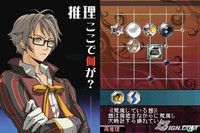|
|

|
PLATFORM
|
DS
|
BATTLE SYSTEM
|

|
INTERACTION
|

|
ORIGINALITY
|

|
STORY
|

|
MUSIC & SOUND
|

|
VISUALS
|

|
CHALLENGE
|
Hard
|
LANGUAGE BARRIER
|
Very High
|
COMPLETION TIME
|
Less than 20 Hours
|
|
OVERALL

|
+ Interesting premise and execution.
+ Soundtrack succeeds in rocking out.
+ Every room is unique.
- But not much change in scenery later on.
- Clue management can be a little obtuse.
- You have to hold the DS how?
|
Click here for scoring definitions
|
|
|
Square Enix as a company has a reputation for certain qualities and standards. It frequently pushes the limits of sound and visuals, but the same cannot always be said of story, presentation, or interaction. Sigma Harmonics is a game like nothing else ever published by Square Enix. In most every respect, it is a highly unorthodox game.
Let's begin with the story, as that is the pillar upon which the entirety of the game rests. Sigma Harmonics contains six main chapters and two unlockable chapters, one being an alternate third chapter and the other being insane. All but the final main chapter are presented as murder mysteries. But we're getting ahead of ourselves. The insanity begins with the backstory.
Sigma and his best friend Neon are the youngest scions of the guardians of reality, a grouping of magical lineages with a diverse array of powers. The members of Sigma's clan, the Kurogami, are known to the public as the incredibly rich founders of a business empire, and their mansion is truly a sight to behold. At its center is the Great Clock, which serves a secret purpose: to imprison marauding spirits known as ouma. These beings live outside of time and exist to drive humans to insanity. Fortunately for the world, the Great Clock can hold them. Unfortunately for Sigma and Neon, a mysterious cloaked figure just blew a hole in the barrier. The world as they know it vanishes, and at first they have no idea why. Here is where the game starts. The ouma, being unrestricted by the flow of time, have wrecked the timeline by devastating the household of Kurogami Manor, fifty years in the past.
The good news is that if one defeats the Greater Ouma responsible, even fifty years after the fact, the entire timeline reverts. To find the Greater Ouma, Sigma has to solve the murder or murders that caused the timeline to go out of whack. Ouma are tenacious, however, which is why the player has to navigate up to seven separate murder mysteries, all of which involve the same cast of six to ten characters, only in alternate timelines and occasionally with alternate pasts. As if this weren't confusing enough, the final chapter goes into alternate futures as well, delivering a bizarre and confusing conclusion that would have made the MegaTen writing staff proud.
 My, what big swords you have, Neon.
My, what big swords you have, Neon.
|
|
Solving murders some five decades after the fact may seem an impossible task, but here is where Sigma's special skills shine. The Kurogami magic is sound-based, and with it he can detect "soul shadows" that can be used to replay important scenes in the past. Through these glimpses, Sigma can extract important clues and then encapsulate them in kokuin, or sound bites. When enough sound bites have been found, Sigma can attempt to disperse the darkness and mystery surrounding the murder by properly placing the clues on a grid. While the game rewards good deductive skills, the chapter boss will appear when Sigma comes to a solution to the mystery, no matter what that is. It's quite possible to lead Sigma down the wrong deductive path, causing him to accuse the wrong person, declare the death to be an industrial accident, or even a mass hallucination. The game rates the player higher depending on how well the case has been solved. High ranks reward the player with new abilities, while low ranks boost the difficulty of the chapter boss battle to levels that may be impossible to overcome.
When it comes to combat, it's Neon's power that wins the day. Her family, the Tsukiyumi, are summoners of spirits, and Neon can allow such spirits to ride her in battle, giving her combat skills and prowess that a teenager should not have. There are sixteen spirit cards for her to use, each representing a different attack. Twelve of them match the Chinese zodiac, while the last four are a little more eclectic. Some of them are available from the start, but more can only be acquired by getting top ranks on the game's chapters. One, the Triple Kitties, is the subject of a sort of side-quest in either the second or third chapter. As the field of battle has Neon at the center and surrounded by enemies, many of the attacks have associated movement attached to them, such as "attack left," "attack right," or "slash wildly at random." Others give boosts like regeneration or defense against status changes.
Salted among the regular enemies are stronger monsters that give rewards when defeated. Beating one of these will gain Skill Points for Neon. The amount varies according the type of ouma, and bonuses apply for battles finished quickly or with certain conditions met. Karuma, violent ouma that wander the halls of the manor, give more Skill Points, as well as the occasional hint to solving a case, but are also very dangerous to take on. The most Skill Points are to be had from the game's bosses. With enough Skill Points and the right sort of spirit available, Neon can unlock various job classes. The basic three are Student, Swordmaiden, and Gun Girl, with the higher classes being upgrades of these. Each type has its strengths and weaknesses. The Student has access to the best healing skills, the Swordmaiden has the highest base attack power, and the Gun Girl does best with attacks that shift targets to the left or right.
 A clue in the hand is worth two in the bush.
A clue in the hand is worth two in the bush.
|
|
In battle, the player must direct Neon by choosing and dragging cards into the activation spot on the screen. There are always three stacks of cards, and a simple tap is enough to flip through the various cards. Each stack charges separately, and is subject to status freezing by enemies. It sounds simple enough, but as there is no pausing in the fast-paced battles it's easy to make a simple mistake in skill choices that could spell doom in the tougher battles.
Music plays a surprising role in this game. While Neon can choose any one spirit card to determine her job class, not all the abilities for that class may be available. To determine which skills are currently active, Sigma must use one of the other fifteen cards to set the battle music. Different battle tunes change the available skillset as well as the speed with which the skills charge. The soundtrack is the handiwork of Masashi Hamauzu, and is one of the highlights of the game. With a large number of potential battle tunes, some good environmental tracks, and a final boss theme worthy of the weirdness that is the endgame, the entire soundtrack rocks out. It's no surprise that the Sigma Harmonics soundtrack commands a price two or three times higher than the game itself in Japanese used game stores.
One important detail about this game has yet to be mentioned, and yet it's the most important one in terms of interaction in this game — the game is played sideways. Rather, the DS must be held sideways in order to play the game. Think Garage, the studio that created Sigma Harmonics, made the odd decision to take a design aspect occasionally seen in DS adventure titles, with the upper and lower DS screens converted to left and right. For a better idea of what this is like, simply look at any of the screens used in this review. Occasionally, major dramatic splash pages will be stretched across both screens, and the effect can be almost stereoscopic at times. The directional buttons can be used to move Sigma around, but the sideways playing style makes them practically useless. This is definitely a game that was intended to be played with a stylus in the right hand and the DS in the palm of the left. If there is a way to switch this game around to make it lefty-friendly, it is not mentioned in the game's manual.
 It was Col. Peacock in the Conservatory with the Parsnip!
It was Col. Peacock in the Conservatory with the Parsnip!
|
|
Sigma Harmonics is a very visual game. The bulk of the action occurs within the Kurogami Manor, which could have made for a very repetitive game experience. Yet, every room in the building is unique and detailed, and the various pieces of scene art are beautiful. Ouma appear as bizarre amalgamations of animals and technology, such as typewriter fiddler crabs or telephone cord ostriches. The human and humanoid characters have very expressive portrait work, and oftentimes this helps carry the story scenes better than plain sprites could.
Even so, this game is just not import-friendly. It is very text-heavy, with most of that text being important to understanding the plot. There are no NPCs or throwaway text in this game, so the average information density is also very high. In order to solve the mysteries properly and without an FAQ requires the player to have good deductive reasoning on top of a command of the language that is sufficient to distinguish inferred information and special connotations from regular text. If it weren't for the fact that it's not required for the player to solve the mysteries correctly, then this game would need a special language barrier ranking. Perhaps something along the lines of "Nigh Unplayable Without Solid Knowledge of the Language and/or a Really Good FAQ." As it is, the FAQ is still recommended even for people who can read the game. One thing in its favor would be the length, however. Even replaying some of the chapters in order to get a better ranking (which is highly recommended), the game can be completed in less than twenty hours. So at least this one isn't umpteen hours long, like some text-heavy Japanese games.
My final thoughts for this game could be summed up as, "Seriously, this was a Square Enix game?" In just about every design choice, Sigma Harmonics is definitely outside of the company's usual comfort zone. In terms of tone, style, and bizarre story twists, this title is right up there with the weirdest games Atlus has ever produced in terms of sheer Whiskey Tango Foxtrot. It kept me playing, even though I freely admit to using FAQs to ensure S ranks on the later chapters (in which not all the important clues are obvious). I did manage an A ranking on the first chapter without any assistance, and of that I am proud.
Review Archives
|









